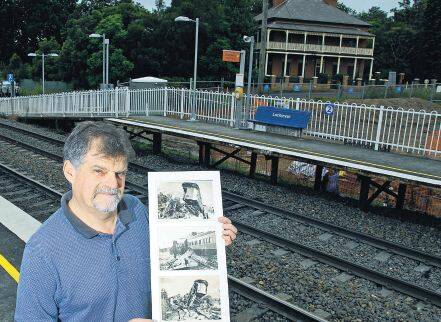
It’s been 150 years since one of the most important rail corridors of the Hunter Valley carried the first trains between Lochinvar and Branxton. SAM NORRIS reports on the line that helped open up the Hunter and beyond.
Subscribe now for unlimited access.
or signup to continue reading
It’s a trip few would spare a second thought on in 2012, in their cars travelling the 15 kilometres or so between Lochinvar and Branxton. But 150 years ago yesterday the opening of a 13 kilometre rail line between those towns, through Greta, was a coup in many ways.
The Model T Ford was almost 50 years away and even horses were a luxury, making the railway line a nation-building necessity. It just happened to make travel a bit easier too.
Lochinvar resident and rail buff Bill Sutherland wasn’t even aware of the March 23 milestone.
He moved to Old North Rd a decade ago with a disused 22 metre sleeper car, where he found a suitable acreage for the old carriage.
“It is a bit poetic that it was beside this rail line,” he said. “I was pretty keen to get hold of some old photos when I moved in.”
The line was the beginning of the Great Northern Railway which would snake its way up through the Hunter, past Murrurundi, on its way to Tamworth, Armidale and Glen Innes.
Co-author of Our region, our railway: the Hunter and the Great Northern Railway, David Sheedy, agreed the line’s regional significance could not be denied but said it was part of a much bigger vision.
“They were trying to open the country by servicing all the farming communities, bringing wool and wheat back for local needs and export overseas,” he said. “They were very conscious of providing mail and passenger services on that line too.”
The line installation included the construction of stations and associated buildings at Lochinvar, Greta and Branxton.
The Lochinvar station building circa 1860 was demolished 10 years ago and the existing platform only dates back to 1914. On July 26 of that year the original platform was torn down to install a second line rather than run track either side of it.
The Branxton station is undoubtedly the pearl of the existing infrastructure.
“Beside Fairfield (1856) it is the oldest station in the state,” Mr Sheedy said. “The line (out of Maitland) is one of our most important ones remaining, with the Branxton station. The Greta station is pretty old too.”
For the first 10 years of its life the Greta station was known as Farthings.
“In 1862 William Farthing found a coal seam between Lochinvar and Black Creek so it was likely named after him,”
Mr Sheedy said. “Ten years later it was renamed as Greta.”
The attached station house at Greta (1850), that still stands, predates even the Branxton station.
“Quite often they would acquire existing cottages as the stationmaster’s headquarters,” he said.
Coincidently, it is now on the market.
Comparatively few passengers have used the Maitland to Singleton line in recent years.
Perhaps fittingly, in the lead up to the Singleton-Branxton line’s 150th anniversary, another rail buff and Maitland institution hailed it as a line of the future.
“Mr Maitland”, Milton Morris, state MP from 1956 to 1980, said: “That Lochinvar, Greta, Branxton area is absolutely booming so it could be a very important piece of infrastructure,” he said. “Just look at all the cars
on our roads coming downfrom there and mostly with no passengers.”

